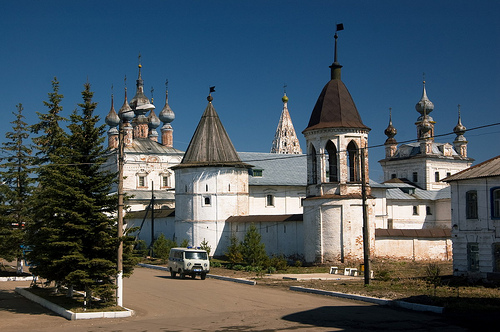

The Archangel Michael Monastery is an Orthodox monastery of the Alexander Diocese of the Russian Orthodox Church, located in the center of Yuryev-Polsky, Vladimir Oblast. It is a valuable architectural ensemble of the 17th and 18th centuries, combining elements of fortress and church architecture, and is listed as a cultural heritage site of Russia. The monastery occupies the site of a former 13th-century city fortress and is one of the oldest in Opolye, a historical region of the Vladimir lands. Below, I will describe in detail its history, architecture, interior, and current state.
The monastery was founded in the 13th century by Prince
Svyatoslav Vsevolodovich, son of Vsevolod the Big Nest, between 1230
and 1240 as a fortification to protect the city. Initially, it was a
wooden fortress with a church dedicated to the Archangel Michael,
patron saint of the military. In 1560, the first stone church, the
Cathedral of the Archangel Michael, was built with funds from Prince
Ivan Mikhailovich Kubensky. In 1636, the church was expanded, adding
galleries on three sides.
The monastery experienced a period of
prosperity in the 17th century: stone walls with towers were erected
in the 1680s, and the gate church of St. John the Theologian was
built in 1684–1685. In 1718, the wooden Church of St. George was
moved here from the village of Yegorye. In 1764, during the
secularization of the monastery lands by Catherine II, the monastery
was abolished, and its property was transferred to the treasury; the
churches became parish churches.
From 1792 to 1806, a new
Archangel Cathedral was built on the site of the dilapidated
cathedral, funded by the townspeople. In the 19th century, the
monastery served as a parish, but during the Soviet era (from the
1920s onward), it was closed, and the buildings were transferred to
a museum. During the Great Patriotic War, it housed a hospital. In
1991, the monastery resumed its activities as a men's monastery, and
in 2011, it was completely transferred to the Russian Orthodox
Church. Today, a small community of monks lives there, and
restoration work is underway.
The monastery is a fortified complex covering approximately 1.5
hectares, surrounded by 17th-century stone walls approximately 500
meters long, 5–7 meters high, and up to 2 meters thick. The walls are
reinforced by six towers: three round corner (watchtowers) with tented
roofs and three square passage towers. Ancient defensive embrasures,
including slit-shaped, base-mounted, and overhanging ones, have been
preserved. The western wall is the oldest, dating from the 17th century,
with three old towers.
The central structure is the Cathedral of
the Archangel Michael (1792–1806), a pillarless, five-domed church in
the classical style with Baroque elements. This tall, slender building
is richly decorated with rustication, carved cornices, friezes, and
pilasters. Nearby is a 17th-century tented bell tower, one of the
tallest in Opole, with decorative elements. Other buildings include the
Gate Church of St. John the Theologian (1684–1685) with a tented roof
and kokoshniks; the wooden Church of St. George (1718)—an example of a
three-part church in the style of a Russian izba (refectory, barn, and
altar), built with an axe rather than a saw. There is also an abbot's
quarters and cell buildings from the 18th and 19th centuries. The
complex blends harmoniously into the urban landscape, with its
surrounding earthen rampart and moat.
The monastery's interiors are austere, yet impressive in their historical ambiance. The Archangel Cathedral contains a spacious, bright hall with a closed vault, without frescoes, but with a 19th-century iconostasis and icons, including an image of the Archangel Michael. Ancient icons and carved elements have been preserved in the Church of St. George. The Gate Church of St. John the Theologian has a modest interior with paintings on biblical themes. The monastery houses relics, such as the relics of local saints and ancient books. The atmosphere, with its silence, icons, and candles, underscores the monastic spirit.
The Archangel Michael Monastery is a symbol of the history of Yuryev-Polsky, associated with the princes of Vladimir and the defense of Russian lands. It is part of Russia's Golden Ring and attracts pilgrims and tourists as an example of a fortress monastery. Today, the monastery is active: services, tours, and festivals are held. The grounds are well-maintained, with a garden and a chapel. Visits are possible daily (admission is free, but donations are welcome). Address: Yuryev-Polsky, 1 Maya Street, 1. I recommend checking the schedule on the website of the Alexandrov Diocese or the monastery.